| Article ID | Journal | Published Year | Pages | File Type |
|---|---|---|---|---|
| 6438967 | Geochimica et Cosmochimica Acta | 2013 | 16 Pages |
Abstract
The Mg isotopic compositions of 47 well-characterized lunar samples, including mare basalts, highland rocks, regolith breccias, and mare and highland soils were measured to address the behavior of Mg isotopes during lunar magmatic differentiation, constrain the Mg isotopic composition of the Moon, and evaluate the degree of Mg isotopic fractionation between planetary bodies. The δ26Mg values range from â0.61 ± 0.03â° to 0.02 ± 0.06â° in 22 mare basalts, from â0.34 ± 0.04â° to â0.18 ± 0.06â° in 3 highland rocks, from â0.33 ± 0.05â° to â0.14 ± 0.08â° in 7 regolith breccias, from â0.23 ± 0.05â° to â0.14 ± 0.07â° in 6 highland soils, and from â0.41 ± 0.05â° to â0.20 ± 0.09â° in 9 mare soils. The limited Mg isotopic variation among bulk mare and highland soils and regolith breccias indicates negligible Mg isotope fractionation by lunar surface processes. By contrast, the large Mg isotopic fractionation between low-Ti and high-Ti basalts suggests the source heterogeneity produced during fractional crystallization of the lunar magma ocean, with ilmenite having lighter Mg isotopic compositions than olivine and pyroxene. Overall, the Moon has a weighted average Mg isotopic composition (δ26Mg = â0.26 ± 0.16â°) indistinguishable from the Earth (δ26Mg = â0.25 ± 0.07â°) and chondrites (δ26Mg = â0.28 ± 0.06â°), suggesting homogeneous Mg isotopic distribution in the solar system and the lack of Mg isotope fractionation during the Moon-forming giant impact.
Related Topics
Physical Sciences and Engineering
Earth and Planetary Sciences
Geochemistry and Petrology
Authors
Fatemeh Sedaghatpour, Fang-Zhen Teng, Yang Liu, Derek W.G. Sears, Lawrence A. Taylor,
